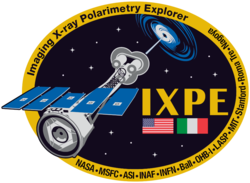X射线偏振探测器
外观
 IXPE satellite, on the top are its three identical X-ray optics elements, the sensors are on the bottom. | |
| 名称 | Explorer 97 IXPE SMEX-14 |
|---|---|
| 任务类型 | X射线天文学 |
| 运营方 | NASA, ASI |
| 国际卫星标识符 | 2021-121A |
| 卫星目录序号 | 49954 |
| 网站 | ixpe asi.it/ixpe |
| 任务时长 | 5年 3年5个月又2天 (in progress) |
| 航天器属性 | |
| 航天器 | Explorer XCVII |
| 航天器类型 | Imaging X-ray Polarimetry Explorer |
| 平台 | BCP-100 |
| 制造方 | 鲍尔航空航太技术公司 OHB Italia |
| 发射质量 | 330千克(730磅)[1] |
| 有效载荷质量 | 170千克(370磅) |
| 尺寸 | 1.1米(3英尺7英寸) in diameter and 5.2米(17英尺) tall, fully extended Solar array: 2.7米(8英尺10英寸) fully deployed |
| 任务开始 | |
| 发射日期 | 9 December 2021, 06:00 UTC[3] |
| 运载火箭 | 猎鹰9号运载火箭 |
| 发射场 | 肯尼迪太空中心 |
| 承包方 | SpaceX |
| 运营开始时间 | 10 January 2022[2] |
| 轨道参数 | |
| 参照系 | 地心轨道 |
| 轨域 | 低轨道 |
| 近gee点 | 540 km(340 mi) |
| 远gee点 | 540 km(340 mi) |
| 倾角 | 0.20° |
| 周期 | 90.00 minutes |
| 主望远镜 | |
| 类型 | Three-mirror |
| 焦距 | 4 m[4] |
| 波长 | X射线 |
| 转发器 | |
| 频带 | S波段[5] |
 IXPE mission logo | |
X射线偏振探测器(Imaging X-ray Polarimetry Explorer)是一座拥有三台相同望远镜的太空观测站,用来测量黑洞、中子星和脉冲星的宇宙X射线偏振[6]。X射线偏振探测器于 2021 年 12 月 9 日发射,是美国国家航空航天局和意大利太空总署的国际合作计划。X射线偏振探测器是美国国家航空航天局探索者计划的一部分,该计划旨在设计低成本的太空船来研究太阳物理学和天文物理学。
X射线偏振探测器任务将研究奇异天体,并绘制黑洞、中子星、脉冲星、超新星遗迹、磁星、类星体和活动星系核的磁场图。这些天体周围环境发出的高能量X射线辐射可以极化—在特定方向上振荡。研究X射线的偏振可以揭示这些天体的物理特性,并能深入了解它们产生的高温环境[7]。
科学研究目标
[编辑]技术与科学研究目标包括:[3]
- 将偏振灵敏度提高两个数量级,高于轨道太阳天文台上搭载的X射线偏振仪
- 同时提供光谱、空间和时间测量
- 确定活动星系核和类星体的几何形状和发射机制
- 找到磁星中的磁场配置并确定磁场的大小
- 找到脉冲星中X射线产生的机制及其几何形状
- 确定脉冲星风云中的粒子是如何加速的
建造
[编辑]X射线偏振探测器由鲍尔航空航太技术公司(Ball Aerospace & Technologies)所建造[1]。首席研究员是美国国家航空航天局马歇尔太空飞行中心的马丁·魏斯科普夫(Martin C. Weisskopf),他是美国国家航空航天局马歇尔太空飞行中心X射线天文学首席科学家,也是钱德拉X射线天文台的计划科学家。 [7]
设备
[编辑]X射线偏振探测器拥有三台相同的望远镜,用于测量宇宙X射线的偏振[6],偏振探测器由意大利国家天文物理研究所(INAF) 和意大利国家核物理研究所(INFN) 的科学家发明和开发,经过数年的改进[4][8][9]。
参考文献
[编辑]- ^ 1.0 1.1 IXPE (Imaging X-ray Polarimetry Explorer). eoportal.com. ESA. [17 February 2019]. (原始内容存档于30 April 2024).
- ^ IXPE X-ray observatory completes commissioning, eyes Cassiopeia A for calibration. NASASpaceFlight.com. 10 January 2022 [11 January 2022]. (原始内容存档于11 January 2022).
- ^ 3.0 3.1 IXPE Home: Expanding the X-ray View of the Universe. Marshall Space Flight Center (MSFC). NASAemberdate=39. 2021. (原始内容存档于2 October 2021).
- ^ 4.0 4.1 Weisskopf, Martin C.; Ramsey, Brian; o'Dell, Stephen L.; Tennant, Allyn; Elsner, Ronald; Soffitta, Paolo; Bellazzini, Ronaldo; Costa, Enrico; Kolodziejczak, Jeffery; Kaspi, Victoria; Muleri, Fabio; Marshall, Herman; Matt, Giorgio; Romani, Roger. The Imaging X-ray Polarimetry Explorer (IXPE). Results in Physics. 31 October 2016, 6: 1179–1180. Bibcode:2016ResPh...6.1179W. doi:10.1016/j.rinp.2016.10.021
 . hdl:2060/20160007987
. hdl:2060/20160007987  .
.
- ^ IXPE Fact Sheet (PDF). NASA. 2017 [2 February 2018]. (原始内容存档 (PDF)于2 April 2019).
 本文含有此来源中属于公有领域的内容。
本文含有此来源中属于公有领域的内容。
- ^ 6.0 6.1 NASA Selects Mission to Study Black Holes, Cosmic X-ray Mysteries. NASA. 3 January 2017 [6 December 2021]. (原始内容存档于8 December 2021).
 本文含有此来源中属于公有领域的内容。
本文含有此来源中属于公有领域的内容。
- ^ 7.0 7.1 NASA selects X-ray astronomy mission. SpaceNews. 4 January 2017 [9 December 2021]. (原始内容存档于30 April 2024).
- ^ Costa, Enrico; Soffitta, Paolo; Bellazzini, Ronaldo; Brez, Alessandro; Lumb, Nicholas; Spandre, Gloria. An efficient photoelectric X-ray polarimeter for the study of black holes and neutron stars. Nature. 2001, 411 (6838): 662–665. Bibcode:2001Natur.411..662C. PMID 11395761. S2CID 4348577. arXiv:astro-ph/0107486
 . doi:10.1038/35079508.
. doi:10.1038/35079508.
- ^ Bellazzini, R.; Spandre, G.; Minuti, M.; Baldini, L.; Brez, A.; Latronico, L.; Omodei, N.; Razzano, M.; Massai, M. M.; Pesce-Rollins, M.; Sgrò, C.; Costa, E.; Soffitta, P.; Sipila, H.; Lempinen, E. A sealed Gas Pixel Detector for X-ray astronomy. Nuclear Instruments and Methods in Physics Research Section A. 2017, 592 (2): 853–858. Bibcode:2007NIMPA.579..853B. S2CID 119036804. arXiv:astro-ph/0611512
 . doi:10.1016/j.nima.2007.05.304.
. doi:10.1016/j.nima.2007.05.304.
